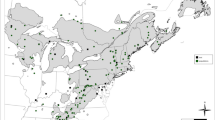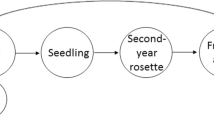Abstract
Plant adaptations to fire often display spatial heterogeneity associated with geographical variation in fire regime. We examined whether populations of the Tecate cypress (Hesperocyparis forbesii Adams) in southern California and northern Baja, Mexico, exhibited spatial heterogeneity in cone serotiny, in other life history traits associated with fire-adaptation, and in population demographic structure, to assess a putative difference in fire regime across the USA–Mexico border. Demographic data, tree life history data, and tree ring series were used to compare the demographic structure and life history traits of three populations in southern California with three populations in northern Baja California. In Baja populations, a greater number of tree size classes were present (χ 2 = 12,589; P < 0.05), cone serotiny was more facultative (Mann–Whitney U = 58, P < 0.05), and young adult trees had a higher reproductive output (Mann–Whitney U = 2.65, P < 0.05), suggesting that a difference in fire regime between southern California and northern Baja has existed long enough (ca 8000 years) to drive microevolutionary divergence between the two sets of populations, and is not solely the result of 20th century differences in fire management policies across the international border. The transitional area between the two different fire regimes does not appear to coincide with the border itself but may lie in a zone of ecological transition south of Ensenada. The range of phenotypic variation observed within the Tecate cypress metapopulation suggests this species has the capacity to adapt to future environmental changes.


Similar content being viewed by others
References
Barbour MG (2007) Closed-Cone Pine and Cypress Forests. In: Barbour MG, Keeler-Wolf T, Schoenherr AA (eds) Terrestrial vegetation of California. University of California Press, Berkeley, pp 296–312
Bond WJ, Keeley JE (2005) Fire as a global ‘herbivore’: the ecology and evolution of flammable ecosystems. Trends Ecol Evol 20:387–394
Borchert MI, Odion DC (1995) Fire intensity and vegetation recovery in chaparral: a review. In: Keeley JE, Scott T (eds) Brushfires in California Wildlands: ecology and resource management. Int Assoc Wildland Fires, Fairfield, pp 91–100
Chou YH, Minnich RA, Dezzani RJ (1993) Do fire sizes differ between southern California and Baja-California? For Sci 39:835–844
Cowling RM, Lamont BB (1985) Variation in serotiny of three Banksia species along a climatic gradient. Aust Ecol 10:345–350
de Gouvenain RC, Ansary AM (2006) Association between fire return interval and population dynamics in four California populations of Tecate cypress (Cupressus forbesii). Southwest Nat 51(4):447–454
Dunn AT (1986) Population dynamics of the Tecate cypress. In: Elias TS (ed) Conservation and management of rare and endangered plants. California Native Plant Society, Sacramento, pp 367–376
Enright NJ, Marsula R, Lamont BB, Wissel C (1998) The ecological significance of canopy seed storage in fire-prone environments: a model for non-sprouting shrubs. J Ecol 86:946–959
Falk DA, Heyerdahl EK, Brown PM, Farris C, Fulé PZ, McKenzie D, Swetnam TW, Taylor AH, Van Horn ML (2011) Multi-scale controls of historical forest-fire regimes: new insights from fire-scar networks. Front Ecol Environ 9(8):446–454
Fites-Kaufman J, Bradley AF, Merrill AG (2006) Fire and Plant Interactions. In: Sugihara NG, Van Wagtendonk JW, Shaffer KE, Fites-Kaufman J, Thode AE (eds) Fire in California’s ecosystems. University of California Press, Berkeley, pp 94–117
Franco-Vizcaino E, Sosa-Ramirez J (1997) Soil properties and nutrient relations in burned and unburned Mediterranean-climate shrublands of Baja California, Mexico. Acta Oecol 18(4):503–517
Fulé PZ, Covington WW (1999) Fire regime changes in La Michilia Biosphere Reserve, Durango, Mexico. Conserv Biol 13:640–652
Gauthier S, Bergeron Y, Simon J-P (1993a) Cone serotiny in jack pine: ontogenetic, positional, and environmental effects. Can J For Res 23:394–401
Gauthier S, Gagnon J, Bergeron Y (1993b) Population age structure of Pinus banksiana at the southern edge of the Canadian Boreal Forest. J Veg Sci 4:783–790
Gauthier S, Bergeron Y, Simon JP (1996) Effects of fire regime on the serotiny level of jack pine. J Ecol 84:539–548
Gavin DG, Hallett DJ, Hu FS, Lertzman KP, Prichard SJ, Brown KJ, Lynch JA, Bartlein P, Peterson D (2007) Forest fire and climate change in western North America: insights from sediment charcoal records. Front Ecol Environ 5(9):499–506
Gill AM (1977) Plant traits adaptive to fires in Mediterranean land ecosystems. In: Mooney HA, Conrad CE (eds) Symposium on the environmental consequences of fire and fuel management in Mediterranean ecosystems. USDA Forest Service, Palo Alto, pp 17–26
Givnish TJ (1981) Serotiny, geography, and fire in the Pine Barrens of New Jersey. Evolution 35:101–123
Hanes TL (1988) California chaparral. In: Barbour MG, Major J (eds) Terrestrial vegetation of California. John Wiley & Sons, New York, pp 417–469
Hogan D (2004) Emergency petition to list the Thorne’s hairstreak butterfly (Callophrys [Mitoura] thornei or Callophrys [Mitoura] grynea thornei) as endangered under the Endangered Species Act. Center for Biological Diversity, Tucson
Keeley JE (1992) Recruitment of seedlings and vegetative sprouts in unburned chaparral. Ecology 73:1194–1208
Keeley JE (2006) South Coast Bioregion. In: Sugihara NG, Van Wagtendonk JW, Shaffer KE, Fites-Kaufman J, Thode AE (eds) Fire in California’s ecosystems. University of California Press, Berkeley, pp 350–390
Keeley JE, Fotheringham CJ (2001a) Historic fire regime in southern California shrublands. Conserv Biol 15:1536–1548
Keeley JE, Fotheringham CJ (2001b) History and management of crown-fire ecosystems: a summary and response. Conserv Biol 15:1561–1567
Keeley JE, Swift CC (1995) Biodiversity and ecosytem functioning in Mediterranean-climate California. In: Davis GW, Richardson DM (eds) Mediterranean-type ecosystems: the function of biodiversity. Springer, Berlin, pp 121–183
Keeley JE, Zedler PH (2009) Large, high-intensity fire events in southern California shrublands: debunking the fine-grain age patch model. Ecol Appl 19:69–94
Lamont BB, Enright NJ (2000) Adaptive advantages of aerial seed banks. Plant Species Biol 15:157–166
Little EL Jr (1975) Rare and local conifers in the United States. US Department of Agriculture, Forest Service, Washington
Minnich RA (1983) Fire mosaics in southern-California and northern Baja California. Science 219:1287–1294
Minnich RA (2001) An integrated model of two fire regimes. Conserv Biol 15:1549–1553
Minnich RA (2002) Divergence in Californian vegetation and fire regimes induced by differences in fire management across the U.S.-Mexico boundary. In: Fernandez L, Carson RT (eds) Both sides of the border: transboundary environmental management issues facing Mexico and the United States. Kluwer Academic Publishers, Dordrecht, pp 387–399
Minnich RA (2006) California Climate and Fire Weather. In: Sugihara NG, Van Wagtendonk JW, Shaffer KE, Fites-Kaufman J, Thode AE (eds) Fire in California’s Ecosystems. University of California Press, Berkeley, pp 13–37
Minnich RA, Chou YH (1997) Wildland fire patch dynamics in the chaparral of southern California and northern Baja California. Int J Wildland Fire 7:221–248
Minnich RA, Everett RG (2001) Conifer tree distributions in southern California. Madroño 48:177–197
Minnich RA, Franco-Vizcaíno E (2005) Baja California’s enduring Mediterranean vegetation: early accounts, human impacts, and conservation status. In: Cartron JE, Ceballos G, Felger RS (eds) Biodiversity, ecosystems, and conservation in Northern Mexico. Oxford University Press, Oxford, pp 370–386
Montenegro G, Ginocchio R, Segura A, Keeley JE, Gómez M (2004) Fire regimes and vegetation responses in two Mediterranean-climate regions. Rev Chil Hist Nat 77:455–464
Muir PS, Lotan JE (1985) Disturbance history and serotiny of Pinus contorta in Western Montana. Ecology 66:1658–1668
Munz PA, Keck DD (1973) A California flora and supplement. University of California Press, Berkeley
Ne’eman G, Goubitz S, Nathan R (2004) Reproductive traits of Pinus halepensis in the light of fire–a critical review. Plant Ecol 171:69–79
Ornduff R, Faber PM, Keeler-Wolf T (2003) Introduction to california plant life, 2nd edn. University of California Press, Berkeley
Pausas JG, Bradstock RA, Keith DA, Keeley JE (2004) Plant functional traits in relation to fire in crown-fire ecosystems. Ecology 85:1085–1100
Peinado M, Alcaraz F, Aguirre JL, Delgadillo J, Aguado I (1995) Shrubland formations and associations in mediterranean-desert transitional zones of northwestern Baja California. Vegetatio 117:165–179
Peinado M, Aguirre JL, Delgadillo J, Macías MÁ (2008) A phytosociological and phytogeographical survey of the coastal vegetation of western North America. Part I: plant communities of Baja California, Mexico. Plant Ecol 196:27–60
Radeloff VC, Mladenoff DJ, Guries RP, Boyce MS (2004) Spatial patterns of cone serotiny in Pinus banksiana in relation to fire disturbance. For Ecol Manag 189:133–141
Reznick D, Travis J (2001) Adaptation. In: Fox CW, Roff DA, Fairbairn DJ (eds) Evolutionary ecology: concepts and case studies. Oxford University Press, New York, pp 44–57
Rodriguez-Buritica S, Suding K, Preston K (2010) Santa Ana mountains Tecate Cypress (Cupressus forbesii) management plan. California Department of Fish and Game, Sacramento
Rosas Escobar P, Gernandt DS, Piñero D, Garcillán PP (2011) Plastid DNA diversity is higher in the Island Endemic Guadalupe Cypress than in the Continental Tecate Cypress. PLoS ONE 6:e16133
Schoennagel T, Turner MG, Romme WH (2003) The influence of fire interval and serotiny on postfire lodgepole pine density in Yellowstone National Park. Ecology 84:2967–2978
Schwilk DW, Ackerly DD (2001) Flammability and serotiny as strategies: correlated evolution in pines. Oikos :326-336
Stokes MA, Smiley TL (1996) An introduction to tree-ring dating. The University of Arizona Press, Tucson
Sugihara NG, Van Wagtendonk JW, Fites-Kaufman J (2006) Fire as an Ecological Process. In: Sugihara NG, Van Wagtendonk JW, Shaffer KE, Fites-Kaufman J, Thode AE (eds) Fire in California’s ecosystems. University of California Press, Berkeley, pp 58–74
Tapias R, Climent J, Pardos JA, Gil L (2004) Life histories of Mediterranean pines. Plant Ecol 171:53–68
Truesdale HD, McClenaghan LR (1998) Population genetic structure of Tecate cypress (Cupressaceae). Southwest Nat 43:363–373
Tyler CM (1995) Factors contributing to postfire seedling establishment in chaparral: direct and indirect effects of fire. J Ecol 83:1009–1020
Vogl RJ, Armstrong WP, White KL, Cole KL (1988) The closed-cone pines and cypress. In: Barbour MG, Major J (eds) Terrestrial vegetation of California. John Wiley & Sons, New York, pp 295–358
Wright HA, Bailey AW (1982) Fire ecology: United States and southern Canada. John Wiley & Sons, New York
Zedler PH (1977) Life history attributes of plants and the fire cycle: a case study in chaparral dominated by Cupressus forbesii. In: Mooney HA, Conrad CE (eds) Symposium on the environmental consequences of fire and fuel management in Mediterranean ecosystems. USDA Forest Service, Palo Alto, pp 451–458
Zedler PH (1995) Are some plants born to burn? Trends Ecol Evol 10:393–395
Zedler PH, Gautier CR, McMaster GS (1983) Vegetation change in response to extreme events: the effect of a short interval between fires in California chaparral and coastal scrub. Ecology 64:809–818
Acknowledgments
We thank Jim Bartel, Ibes Fabian Davila Flores, Jocelyne and Trevonte de Gouvenain, and Edelyn Ramírez Espinoza for their help in the field, and Kristin Chauvin and Katherine D’Ovidio for their help in preparing and analyzing field samples and tree cores. We thank the Bureau of Land Management and the Forest Service for allowing us to conduct research on federal lands and Saul Martin del Campo for allowing us to conduct research on his property. We are especially grateful to Joyce Schlachter for her logistical assistance. This manuscript benefited from discussions with Jim Bartel, Jon Keeley, Richard Minnich, and Sula Vanderplank, and from comments from three anonymous reviewers. This research was supported by grants from Chapman University, Rhode Island College, the National Science Foundation-Rhode Island Experimental Program to Stimulate Competitive Research (EPSCoR), and in-kind support from the Universidad Autónoma de Baja California, Ensenada, Mexico.
Author information
Authors and Affiliations
Corresponding author
Rights and permissions
About this article
Cite this article
de Gouvenain, R.C., Delgadillo, J. Geographical variation in population demography and life history traits of Tecate cypress (Hesperocyparis forbesii) suggests a fire regime gradient across the USA–Mexico border. Plant Ecol 213, 723–733 (2012). https://doi.org/10.1007/s11258-012-0035-3
Received:
Accepted:
Published:
Issue Date:
DOI: https://doi.org/10.1007/s11258-012-0035-3




